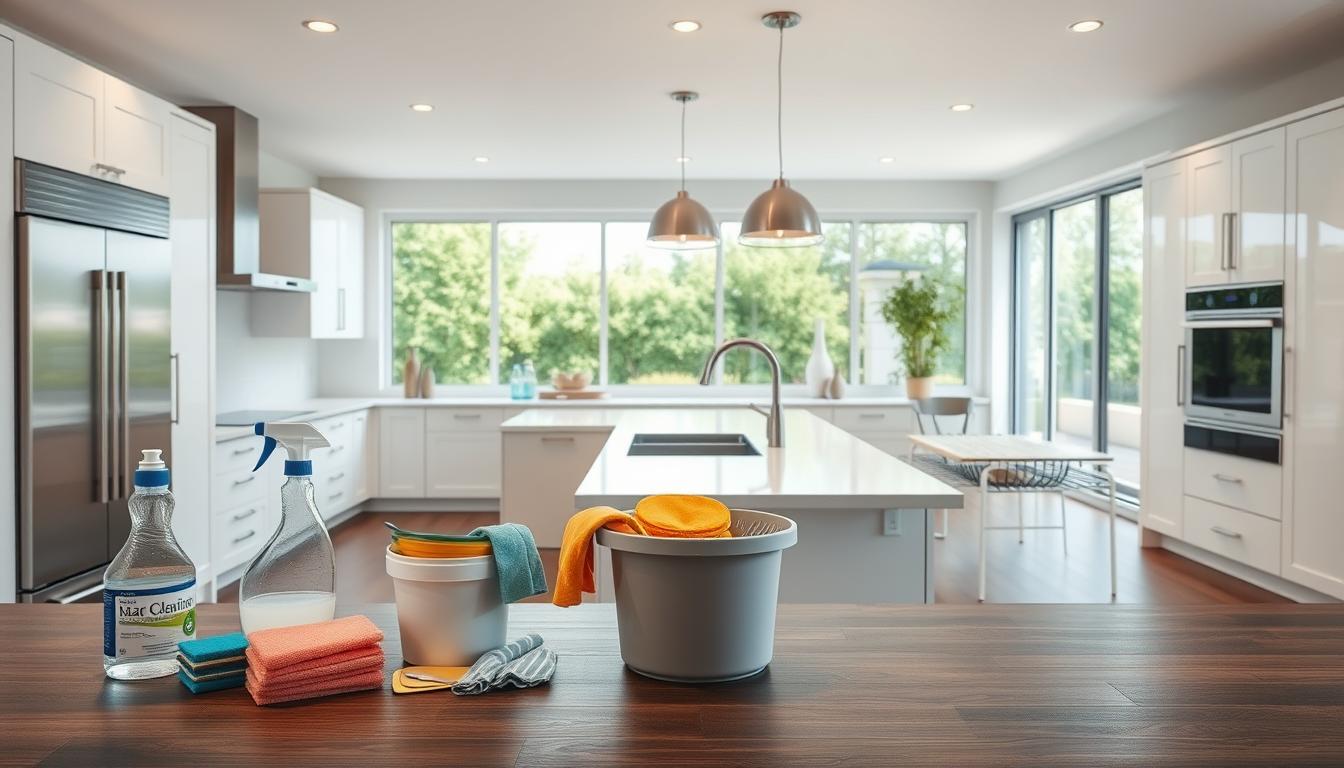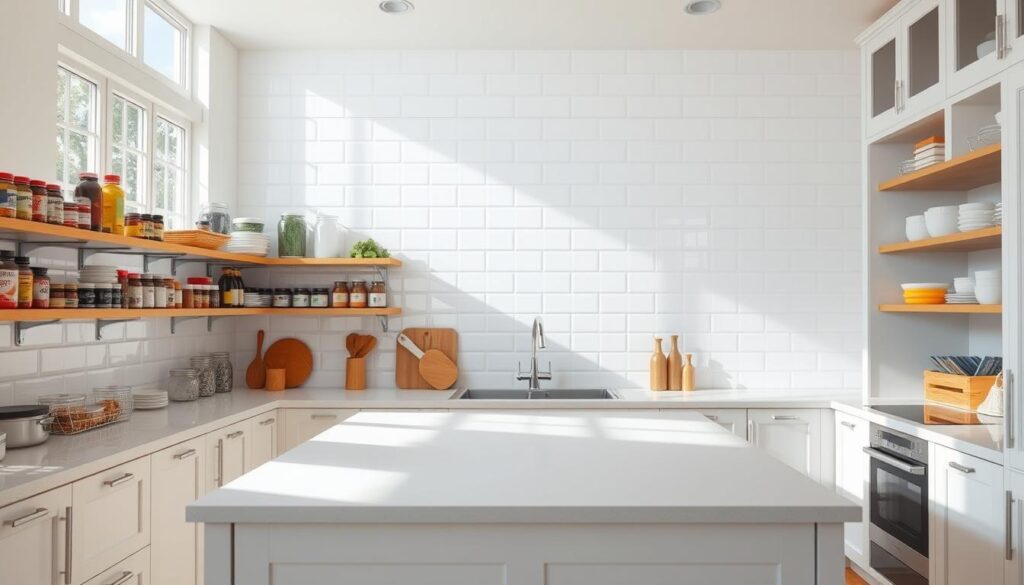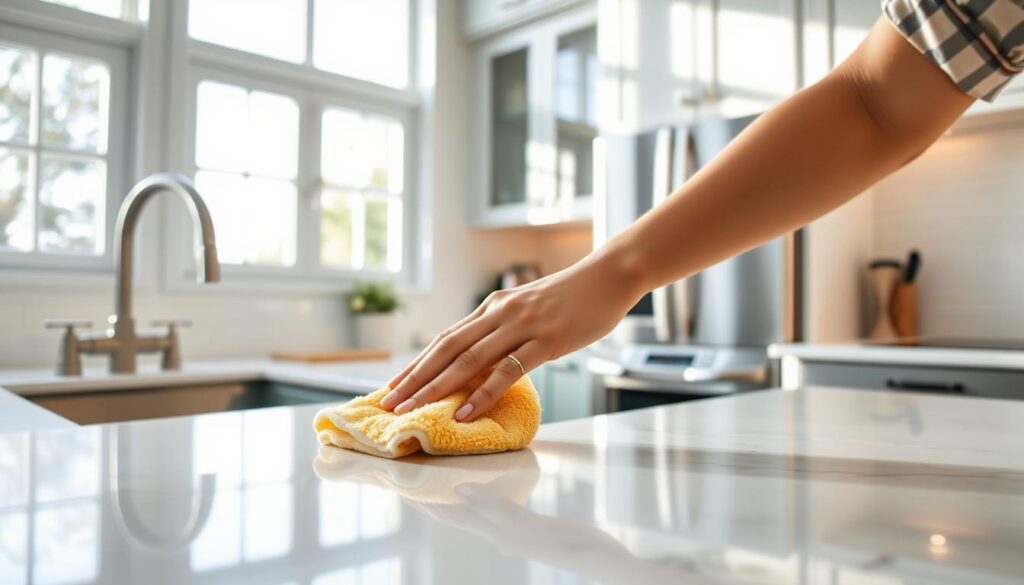Blog
Easy Hair Styling Ideas for Every Occasion

A kitchen deep clean is more than just a routine cleaning task; it’s a thorough process that transforms your cooking space into a spotless and inviting area. Over time, kitchens accumulate grease, grime, and clutter, making them not only unappealing but also unhygienic.
By undertaking a comprehensive deep clean, you can eliminate these issues and create a spotless space that is both healthy and enjoyable to be in. Our 17-point process is designed to guide you through this task, ensuring that every aspect of your kitchen is thoroughly cleaned and sanitized.
Key Takeaways
- Understand the importance of a kitchen deep clean for a healthy home.
- Learn how to achieve a spotless kitchen with our comprehensive guide.
- Discover the benefits of a thorough kitchen deep clean.
- Follow our 17-point process for a meticulously cleaned kitchen.
- Transform your kitchen into an inviting space.
Why Your Kitchen Deserves a Deep Clean
A kitchen deep clean is more than just a chore; it’s a step towards a healthier home. The kitchen is often considered the heart of the home, where meals are prepared and memories are made. However, it’s also a place where bacteria, germs, and grime can accumulate, posing health risks to you and your family.
Health Benefits of a Clean Kitchen
A clean kitchen is essential for maintaining good health. When your kitchen is free from clutter and grime, you’re less likely to harbor bacteria and germs that can cause illness. Deep cleaning your kitchen regularly can help prevent the spread of infections and keep your family healthy. Moreover, a clean kitchen can also reduce stress and make cooking more enjoyable.
The Difference Between Regular and Deep Cleaning
While regular cleaning keeps your kitchen tidy, deep cleaning goes a step further by targeting areas that are often overlooked, such as the inside of appliances, cabinets, and corners where dirt and grime tend to accumulate. Deep cleaning is a more thorough process that ensures your kitchen is not just clean but also hygienic. By incorporating deep cleaning into your routine, you can maintain a healthier and more pleasant cooking environment.
Essential Supplies for a Thorough Kitchen Cleaning
The key to an effective kitchen deep clean lies in having the essential cleaning supplies at your disposal. With the right products and tools, you’ll be able to tackle grime, grunge, and food residue with ease.
Cleaning Products You’ll Need
To start, you’ll need a variety of cleaning products. These include an all-purpose cleaner for general surfaces, a degreaser for tackling grease on your stovetop and oven, and a disinfectant to kill bacteria and germs. Don’t forget a glass cleaner for your windows and any glass surfaces, and a scrubbing powder for tough stains.
| Cleaning Product | Use |
|---|---|
| All-purpose cleaner | General surfaces |
| Degreaser | Stovetop, oven |
| Disinfectant | Countertops, sink |
Tools and Equipment for Effective Cleaning
In addition to cleaning products, having the right tools is crucial. A microfiber cloth is versatile and effective for wiping down surfaces. A scrub brush is necessary for removing stubborn grime, and a mop and bucket are essential for cleaning your kitchen floor. Don’t forget a dustpan and brush for tidying up.
Eco-Friendly Alternatives
For those who prefer a more environmentally friendly approach, there are eco-friendly alternatives available. White vinegar is a natural disinfectant and degreaser, while baking soda can be used as a scrubbing powder. Lemon juice is also a useful cleaning agent, providing a fresh scent and antibacterial properties.
“Cleaning your kitchen with eco-friendly products not only benefits the environment, but also creates a healthier space for you and your family.”
By gathering these essential supplies, you’ll be well-prepared to tackle your kitchen deep clean effectively and efficiently.
Preparing Your Kitchen for a Deep Clean
A well-prepared kitchen is the first step towards a thorough deep clean. Before you start scrubbing and sanitizing, it’s crucial to clear out clutter and create a plan of attack. This preparation phase makes the actual cleaning process more efficient and less overwhelming.
Clearing and Organizing the Space
To start, clear off countertops and declutter your kitchen. Remove any unnecessary items, and sort the remaining items into categories. This will not only make cleaning easier but also help you decide what you need to keep, donate, or discard.
- Empty cabinets and drawers
- Sort items into keep, donate, and discard piles
- Wipe down empty spaces

Creating a Cleaning Plan of Attack
Once your kitchen is decluttered, create a cleaning plan that tackles one area at a time. Start by identifying the dirtiest or most used areas, such as the stove or refrigerator. Break down larger tasks into smaller, manageable chunks, and prioritize them based on importance and urgency.
- Cleaning the stove and oven
- Wipe down cabinets
- Sweep and mop the floors
By following these steps, you’ll be well-prepared to tackle your kitchen deep clean with ease.
The Complete 17-Point Kitchen Deep Clean Checklist
Deep cleaning your kitchen can be a daunting task, but with our 17-point checklist, you’ll be on your way to a sparkling clean kitchen in no time. This comprehensive guide will walk you through the essential steps to achieve a deep clean kitchen, from initial surface cleaning to finishing touches.
Points 1-5: Initial Surface Cleaning
The first step in deep cleaning your kitchen is to tackle the surfaces that are visible and easily accessible. This includes countertops, cabinet exteriors, and other visible areas.
Countertops and Visible Surfaces
Begin by clearing off any clutter or debris from your countertops. Use a gentle cleanser and a microfiber cloth to wipe down the surfaces, paying special attention to any stubborn stains or spills. For tougher stains, consider using a mixture of baking soda and water to create a paste that can help lift the stain.
Cabinet Exteriors and Handles
Next, focus on the exterior of your cabinets and their handles. Use a damp cloth to wipe down the surfaces, removing any grease, dust, or grime. For cabinets with a glossy finish, a gentle furniture polish can help maintain their appearance.
Points 6-10: Appliance Deep Cleaning
Kitchen appliances are not only functional but also contribute significantly to the overall appearance of your kitchen. Deep cleaning these appliances will make a big difference in the overall cleanliness of your kitchen.
Major Appliance Exteriors
Start with the major appliances such as your refrigerator, oven, and dishwasher. Use a gentle cleanser and a soft cloth to wipe down their exteriors, paying attention to any fingerprints, splatters, or spills. For stainless steel appliances, a specialized cleaner can help remove fingerprints and maintain their shine.
Small Appliance Care
Don’t forget about the small appliances like toasters, blenders, and coffee makers. Unplug them and use a damp cloth to wipe down their exteriors. For any removable parts, wash them in soapy water and dry thoroughly before reassembling.
Points 11-15: Storage and Hidden Areas
Deep cleaning isn’t just about visible surfaces; it’s also about tackling the storage and hidden areas where dust, dirt, and grime tend to accumulate.
Pantry and Cabinet Interiors
Empty your pantry and cabinets, and wipe down the interiors with a damp cloth. Check expiration dates of stored food and dispose of any expired or spoiled items. Before putting everything back, consider organizing your storage spaces to maximize efficiency.
Drawers and Utensil Storage
Remove all contents from your drawers and utensil storage containers. Wipe down the interiors and reorganize the contents, discarding any unnecessary or broken items. Consider using dividers or organizers to keep utensils and kitchen tools tidy.
Points 16-17: Finishing Touches
The final steps in your kitchen deep clean involve paying attention to the details that can make a big difference in the overall appearance and feel of your kitchen.
Floors and Baseboards
Sweep and mop your kitchen floors to remove dirt, grime, and any cleaning solution residue. Don’t forget to clean the baseboards, as they can accumulate dust and dirt. Use a damp cloth to wipe them down, and consider using a gentle disinfectant for a more thorough clean.
Windows and Light Fixtures
Finally, clean your kitchen windows and light fixtures. Use a glass cleaner and a lint-free cloth to remove streaks and grime from windows. For light fixtures, dust them gently and use a damp cloth to wipe down any surfaces that are accessible.
By following this 17-point checklist, you’ll be able to achieve a deep clean kitchen that is not only visually appealing but also hygienic and inviting. Regular deep cleaning will help maintain your kitchen’s appearance and functionality over time.
Tackling Major Kitchen Appliances
A deep clean of your kitchen isn’t just about aesthetics; it’s also about ensuring that your major appliances are running at their best. These appliances are not only crucial for the functionality of your kitchen but also represent a significant investment. Regular deep cleaning can extend their lifespan, improve efficiency, and prevent costly repairs.
Refrigerator Deep Cleaning
The refrigerator is one of the most used appliances in the kitchen, making it a prime candidate for deep cleaning. Start by removing all contents and sorting items to be kept, discarded, or refrigerated.
Interior Shelves and Drawers
Remove shelves and drawers and wash them with warm, soapy water. For tough stains, a mixture of baking soda and water can be effective. Ensure all parts are dry before reassembling.
Coils and External Components
Vacuum the coils at the back or bottom of the refrigerator to improve efficiency. Wipe down the exterior with a damp cloth, paying attention to handles and any areas with visible grime.
Oven and Stovetop Restoration
Ovens and stovetops can become grimy and require intense cleaning. For ovens, use a dedicated oven cleaner or a natural alternative like baking soda and vinegar.
Removing Baked-on Residue
Apply the cleaning solution to the interior of the oven and let it sit overnight. The next day, scrub away the grime with a non-abrasive sponge.
Cleaning Burners and Drip Pans
For gas stovetops, remove burners and soak them in hot, soapy water. Drip pans can be cleaned with a similar solution or placed in the dishwasher if they’re dishwasher-safe.
Dishwasher Maintenance and Cleaning
To keep your dishwasher running efficiently, regular maintenance is key. Check and clean the filter regularly to prevent clogs.
Filter and Spray Arm Care
Remove and clean the filter according to the manufacturer’s instructions. Check the spray arms for blockages and run a cleaning cycle if your dishwasher has this feature.
Removing Mineral Deposits
Run a cycle with a dishwasher cleaner or white vinegar to remove mineral deposits and odors, improving the dishwasher’s performance.
Deep Cleaning Kitchen Surfaces
Deep cleaning your kitchen surfaces is a crucial step in maintaining a hygienic and welcoming home. Kitchen surfaces are prone to daily wear and tear, accumulating grime, bacteria, and stains that regular cleaning might miss.

Countertop Materials and Their Care
Different countertop materials require specific care to maintain their durability and appearance. Understanding the type of material you’re working with is key to effective cleaning.
Granite, Marble, and Stone
For granite, marble, and other stone countertops, use a mild detergent and warm water. Avoid acidic or abrasive cleaners that can etch the surface. Regular sealing is also recommended to protect against stains.
Laminate, Wood, and Other Materials
Laminate countertops are more forgiving and can be cleaned with a gentle cleanser and a soft cloth. Wood countertops require oil-based maintenance to keep them moisturized and resistant to scratches. Other materials like stainless steel or quartz have their own specific cleaning requirements.
Cabinet Restoration
Cabinets are not just storage units; they’re also a significant part of your kitchen’s aesthetic. Restoring your cabinets involves both cleaning and, if necessary, repainting or refinishing. Start by removing all contents and dusting the interior. Then, use a suitable cleaner for the material of your cabinets, whether it’s wood, laminate, or another material.
Floor Deep Cleaning by Material Type
Kitchen floors endure a lot, from spills to foot traffic. The cleaning method depends on the floor material. For instance, hardwood floors require a cleaner that’s safe for the finish, while tile floors can often be cleaned with a more robust cleaner, paying special attention to the grout lines.
Addressing Challenging Kitchen Areas
Cleaning a kitchen involves more than just wiping down surfaces; it requires addressing those challenging areas that are prone to grease and stains. These tough spots can be particularly daunting, but with the right strategies, you can restore your kitchen to its former glory.
Grease and Oil Removal Strategies
Grease and oil can accumulate quickly in kitchens, particularly around stovetops and ovens. To remove these stubborn substances, start by applying a degreaser or a mixture of baking soda and water to the affected area. Let it sit for a few minutes before scrubbing with a non-abrasive sponge. For tougher grease, consider using a product containing citrus or vinegar, as these can help break down the grease more effectively.
| Grease Removal Method | Effectiveness | Environmental Impact |
|---|---|---|
| Degreaser | High | Moderate |
| Baking Soda & Water | Moderate | Low |
| Citrus/Vinegar Cleaner | High | Low |
Tackling Stubborn Stains and Buildup
Stubborn stains and buildup can be particularly challenging. For tough stains, apply a stain remover or a paste made from baking soda and water directly to the stain. Let it sit before scrubbing gently. For mineral deposits or lime scale, a product containing acid, such as vinegar or lemon juice, can be effective.
Handling Hard-to-Reach Spaces
Hard-to-reach areas, such as the tops of cabinets or behind appliances, can accumulate dust and grime. Use an extendable duster or a flexible cleaning tool to reach these areas. For tight spaces, consider using a slim cleaning brush or a can of compressed air to dislodge dust and debris.
By addressing these challenging kitchen areas with the right techniques and tools, you can ensure a thorough deep clean that leaves your kitchen looking and feeling fresh and new.
Natural and DIY Cleaning Solutions
The power of natural cleaning solutions lies in their simplicity and effectiveness. By using common household ingredients, you can create potent cleaners that are not only eco-friendly but also gentle on surfaces.
Many natural ingredients have remarkable cleaning properties. For instance, vinegar-based cleaners are excellent for cutting through grease and grime.
Vinegar-Based Cleaners
Vinegar is a versatile cleaning agent that can be used on various surfaces, from countertops to sink basins. Mix equal parts water and white vinegar in a spray bottle for an effective all-purpose cleaner. For tougher grime, let the solution sit for a few minutes before wiping clean.
Baking Soda Applications
Baking soda is another powerhouse for cleaning. It acts as a mild abrasive and can absorb odors effectively. Create a paste by mixing baking soda with water to clean stubborn stains on surfaces like sinks and countertops.
Lemon and Citrus Cleaning Power
Lemons and other citrus fruits are not only great for cooking but also for cleaning. The acidity in lemons makes them effective at cutting through grease and leaving a fresh scent. Use lemon juice mixed with water as a natural disinfectant or add lemon peels to your vinegar solution for an extra boost.
By incorporating these natural and DIY cleaning solutions into your routine, you can maintain a clean and healthy kitchen without exposing yourself to harsh chemicals.
Conclusion: Maintaining Your Kitchen Between Deep Cleans
Maintaining kitchen cleanliness is crucial for a healthy and enjoyable cooking environment. After a thorough deep clean, it’s essential to keep your kitchen tidy between deep cleans. Simple habits like wiping down surfaces after meals, putting away utensils and ingredients, and regularly cleaning appliances can make a significant difference.
To maintain your kitchen’s cleanliness, establish a routine that includes daily and weekly tasks. Daily tasks might include cleaning up after meals, while weekly tasks could involve deeper cleaning of specific areas, such as the oven or refrigerator. By incorporating these habits into your daily routine, you’ll be able to maintain your kitchen’s cleanliness and make future deep cleans more manageable.
Some effective Kitchen Tips for maintaining cleanliness include using a ‘clean as you go’ approach, storing food and ingredients properly, and regularly checking expiration dates. By following these tips and staying committed to your cleaning routine, you’ll be able to enjoy a clean and hygienic kitchen that makes cooking and entertaining a pleasure. Effective Deep Clean Maintenance is all about consistency and attention to detail.
